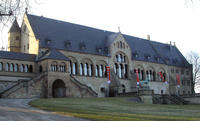You are in: Europe -> Germany -> Mines of Rammelsberg... , and traditional search or Image Gallery will yield results of this site only
Mines of Rammelsberg and Historic Town of Goslar
| Site number: | 623 |
|
| Type of site: | Cultural | |
| Date: | 10-12th century | |
| Date of Inscription: | 1992 | |
| Location: | Europe, Germany, State of Lower Saxony (Niedersachsen), District of Braunschweig | |
| Video: |
|
Up to 75 images are shown here. Click on each for more details or on Image Gallery for more images.
| Description: | Goslar, located near the Rammelsberg mines, occupied a significant place within the Hanseatic League owing to the rich Rammelsberg metallic ore deposits. It was one of the seats of the Holy Roman Empire of the German Nation from the 10th to the 12th century. Its soundly-preserved medieval historic centre holds about 1,500 half-timbered houses that date from the 15th to the 19th century. --WHMNet paraphrase from the description at WHC Site, where additional information is available. | |
| The Mines of Rammelsberg are a UNESCO World heritage site near the German town of Goslar, the site of continuous mineral extraction over a period of more than 1000 years. The Rammelsberg is a mountain, whose summit is at 636 meters above sea level. The mining history of the Rammelsberg occurred as a continuous process in different phases. Initially the main product was silver ore, then later copper, and finally lead. The mines were exhausted only in the 1980s, and were shut down in 1988. Recent archeological findings at the location of Düna (near Osterode) suggest that, in fact, mining at the Rammelsberg had already begun 6-700 years earlier. Layers of an early settlement dated to about the 3rd or 4th century AD located about 25 miles south of the Rammelsberg contained not only pre-industrial melting equipment but also remains of ore, which could clearly be identified as Rammelsberg ore. Goslar is a historic town in Lower Saxony, Germany. It is the administrative centre of the district of Goslar and located on the northwestern slopes of the Harz hills. Goslar and the mines are UNESCO World Heritage Sites. Goslar has a rich history stretching from the Neolithic via the ancient Saxon times, the Holy Roman German empire, Reformation, Enlightenment, German Nationalism, Emancipation, Militarism, German Imperialism, Democratisation, the National Socialist Dictatorship including Racism & Genocide, the Iron Curtain, up to German reunification. In addition Goslar can field an exciting industrial history. Salian Emperor Henry I founded the town in the 10th century after the discovery of silver deposits in the nearby Rammelsberg. The wealth derived from silver mining brought Goslar the status of an Imperial City, which attracted the interest of the Holy Roman Emperor. The Medieval Imperial Palace of Goslar (Kaiserpfalz) was built in the 11th century and became a summer residence for the emperors, especially Henry III of Germany who visited his favourite palace about twenty times. Henry is buried in Goslar. Goslar's Medieval cathedral was built at the same time as the Medieval Imperial Palace, but only the porch survived; the dome itself was torn down in 1820. Other sights are the town hall (16th century) and the ancient mines of the Rammelsberg, which houses now a mining museum. --Wikipedia. Text is available under the Creative Commons Attribution-ShareAlike License. | ||
| Source: | http://whc.unesco.org/en/list/623 | |
| Source2: | http://whc.unesco.org/en/list/623/video | |
| Reference: | 1. UNESCO World Heritage Center, Site Page. | |


 NHK World Heritage 100 series
NHK World Heritage 100 series































